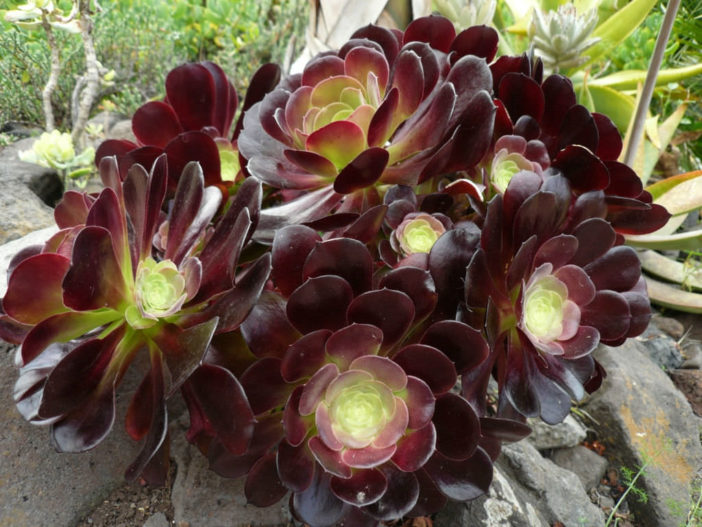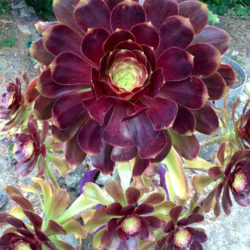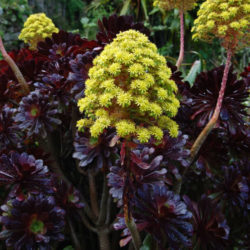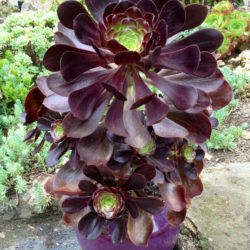Scientific Name
Aeonium 'Voodoo'
Common Name(s)
Giant Red Aeonium
Scientific Classification
Family: Crassulaceae
Subfamily: Sempervivoideae
Tribe: Aeonieae
Genus: Aeonium
Origin
Aeonium 'Voodoo' is a hybrid created by Jack Catlin in Southern California, United States. It results from a cross between Aeonium undulatum and Aeonium arboreum 'Zwartkop' and is a sister seedling of Aeonium 'Cyclops'.
Description
Aeonium 'Voodoo' is a beautiful succulent that forms rosettes of dark reddish-bronze leaves on bare stems. The stems can grow up to 5 feet (1.5 m) tall, usually only branching at the base. The rosettes can reach up to 12 inches (30 cm) in diameter. The color of the leaves changes depending on the season and growing conditions.
The flowers are yellow, star-shaped, and grouped in massive flower heads that rise just above the foliage in spring.

Hardiness
USDA hardiness zone 10a to 11b: from 30 °F (−1.1 °C) to 50 °F (+10 °C).
How to Grow and Care
Aeoniums do not like hot or dry weather. Therefore, they may go dormant in summer and do not require any water, except in very dry conditions. In extreme heat, their leaves will curl to prevent excessive water loss. Growing them in moist shade will keep them growing, but their true growth season is winter to spring when temperatures are cool (65–75˚F / 18–24˚C) and damp. In the winter, water whenever the soil has dried out. Test by poking your finger down into the soil an inch or two. Too much moisture or allowing them to sit in wet soil will cause root rot.
A sandy loam or regular potting mix is better than a mix specifically for cacti and succulents since Aeoniums need some moisture. If you are growing them in containers, repot every 2 –3 years with fresh potting soil.
See more at How to Grow and Care for Aeonium.
Propagate Aeoniums by stem cuttings, except for unbranched species that die after flowering and are propagated from seed. Take cuttings when the plant is actively growing, usually fall in USDA zones 9 through 11. Aeoniums go dormant in summer; cuttings taken while plants are dormant don't root. Each leaf rosette dies after it blooms.
See more at How to Propagate Aeonium.
Link
- Back to genus Aeonium
- Succupedia: Browse succulents by Scientific Name, Common Name, Genus, Family, USDA Hardiness Zone, Origin, or cacti by Genus
Photo Gallery
Click on a photo to see a larger version.


